Performing as a soloist with an orchestra can be a nerve-wracking experience, particularly for competition finalists who have very little rehearsal time. Pauline Harding talks to jury members, conductors and soloists about how to prepare
This feature was originally published in the May 2017 issue of The Strad
MAXIMILIAN HORNUNG
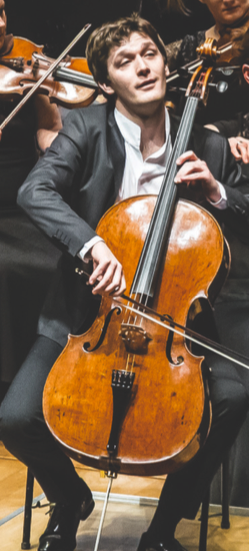
When you are playing a concerto with an orchestra, the most important thing is to be prepared. Practise by yourself, but also with a piano accompanist, so that you know how the piece will sound when everything comes together.
Listening to recordings will help, as will meeting the conductor for half an hour before you rehearse. Get to know each other as people, then talk about the music and approach. I prefer to leave finer details for the rehearsal.
In general, the conductor is the boss and you have to follow, even if you are the soloist. If you disagree with a conductor who is really stubborn, all you can do is try to survive! If you know the piece and the orchestral score well, you should have enough flexibility and freedom to go along with something you might not agree with.
This is unlikely to happen in a competition: most competition conductors and orchestras will be supportive and want to help you. Whoever you are playing with, you will have to adjust. Every orchestra has a different sound: in one the strings will be heavier, in another the woodwinds may project more; another orchestra may keep slowing down, and so on. You never know what is going to happen.
That’s why you rehearse – to find a version of the music, based on your musical intentions and ideas, that the orchestra is happy to support. In the end, it is chamber music and you have to find a diplomatic way to talk to people and to convince them of your ideas. The most common mistake soloists make is to run through the piece as they’ve practised it at home, without feeling a connection with the orchestra.
To work with 80 musicians behind you, you have to have a strong pulse and take more time to breathe, to give them a chance to follow you. You have to exaggerate everything, or nobody will understand what you are trying to do – it will become like a big goulash, where no one really knows what’s inside.
Every expression, every phrase, every articulation, colour and sound, has to be clear. When I was principal cellist of the Bavarian Radio Symphony Orchestra, we played for the finals of the ARD Competition here in Munich, and I remember how difficult a piece could be with one soloist, and how easy the same piece could be with another who was convinced of what they had to do and showed it clearly.
Even if the player doesn’t play everything perfectly, or makes some mistakes, it doesn’t matter, as long as they have a strong feeling of what they want, with an organic pulse and clear, natural phrasing. That way their performance will convince the orchestra, the conductor, the audience and the jury.
Maximilian Hornung is a German cellist, international soloist and winner of the 2012 Echo Klassik award for best cello concerto recording of the year.
Watch: Dvořák Cello Concerto - arranged for five cellos!
Read: How to prepare for a competition: Valentino Worlitzsch, Pacem in Terris Competition
VERA TSU WEILING
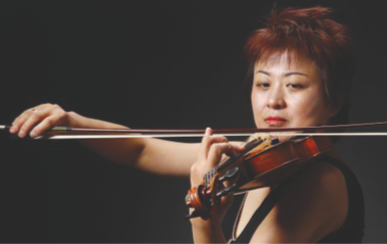
I don’t like it when people say, ‘Oh, he’s always lucky.’ Life doesn’t go like that. People are ‘lucky’ because they work hard, because they are qualified, because they are above a certain level. If you are playing with an orchestra, to study the solo part from the first note to the last is not enough: you have to know the whole score, and you have to be absolutely confident. Be your own master, let people know you are dominant, and lead the orchestra. You have to be 200 per cent prepared.
Even if you are nervous, your mind goes blank, you feel as though your hands won’t move, or conditions are uncomfortable on the stage, you have to force yourself into the music, to let yourself go into another world. Close your eyes; think deeply. Great concentration makes great music, and the more prepared you are, the more room you have to adjust.
Inexperienced soloists are often so afraid of playing wrong notes or having a memory problem that they forget to communicate with the orchestra, they make no eye contact with the conductor, and they play like machines. A performance should be a conversation between the soloist, the conductor and the orchestra; at the same time you have to communicate with the audience. Music should connect, no matter what, through slow notes, long notes, melodic passages, fast passages – even when you have an eight-bar rest while the orchestra plays.
The music never stops, and you have to feel it all, whether you are practising with a pianist or performing on the stage. The more you talk to the conductor before the first rehearsal, the less risk you will face during the concert. When you play, be determined that everything you discussed is going to happen. A good conductor will know exactly what is to be done to help soloists play well; mediocre conductors sometimes waste time and do not help soloists to bring the best side of their playing to the audience. If somehow they lose control during the performance, you have to be calm and cool. Find a way to show them that the speed is not right: you could give a cue, or a very strong beat or rhythm to get their attention. During the concert, sometimes it’s the soloist who doesn’t play at the agreed tempo and goes crazy because of the excitement of being on stage. A good conductor will follow.
Vera Tsu Weiling is a Chinese violin soloist, teacher and jury member at competitions including the International Tchaikovsky Competition, Shanghai Isaac Stern International Violin Competition and Henryk Wieniawski Violin Competition.
Read: Masterclass: Debussy Violin Sonata in G minor
Read: Violist Tabea Zimmermann on the pressure of competitions
MARIN ALSOP
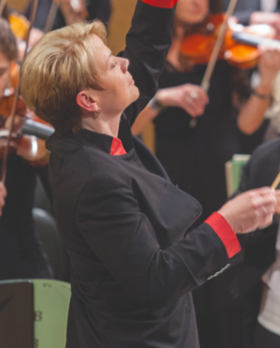
I always meet with young soloists for at least an hour before the first rehearsal. I ask them to play for me, but also I try to get to know them as people, because we have to develop a close rapport very quickly. With the orchestra there are a lot of distractions, so the more I can hear the person play beforehand the better. I try to get a sense of their concept and intent, and the kinds of colours they want to create, so that I can be a good partner with the orchestra.
The main issue that many young soloists face is balancing technical acumen and prowess with musicianship and artistry. Often they err too much on the side of the technical and they lose their musical intent. Especially in a high-pressure competition environment, they can get mired in the details, and the subtleties they want to discuss are so subtle that I don’t necessarily even notice them when we play. Instead I think, ‘Where’s the big line?’ Sometimes I find these discussions about minutiae a little pedantic, when the overview isn’t there.
Some concertos – the Brahms and Beethoven violin concertos, for example – are such symphonic works that they require a musical maturity and overview that include the orchestra as a real partner, and an understanding of the orchestration and sound colours. Playing the notes isn’t enough: you have to have a line and sense of architecture. Playing with an orchestra can be overwhelming, so you have to know the score inside out and have a dialogue with the conductor – don’t just play to the audience. If you are doing a lot of things that the orchestra can’t catch, there’s probably something a little contrived or affected about your interpretation.
There are other pieces that are great for competitions, but that orchestras might not play every day. For example, Bartók’s Second Violin Concerto is tricky for the orchestra and might need more time than something like the Tchaikovsky, which they play all the time. When you’re choosing your piece, think about how you will perform it, how it will come across to the judges and the audience, and what kind of learning curve there will be for the orchestra. Research the orchestra beforehand: watch videos of them accompanying, find out what they’ve played, and look up the conductor. If it’s someone who’s not as comfortable with 21st-century repertoire and you’re trying to choose between playing something from that century or from the century before, that information might influence you. The more knowledge you have, the better off you are.
Whatever happens, keep your sense of humour: it’s a performance, not life and death. Do the best you can in the moment and have fun. Soloists have memory slips, strings break, all kinds of things, but we always manage somehow. As my violin teacher used to say, ‘No matter what, don’t stop.’ That’s our motto!
Marin Alsop is principal conductor of the São Paulo Symphony Orchestra, Brazil and guest conductor of major orchestras worldwide, including the LSO and OAE; conductor at the Queen Elisabeth Music Competition.
Read: In Our Shoes: What does it mean to be a woman in music in 2022?
Read: Cellist Han-na Chang takes conducting role at Symphoniker Hamburg
FRANCESCA DEGO
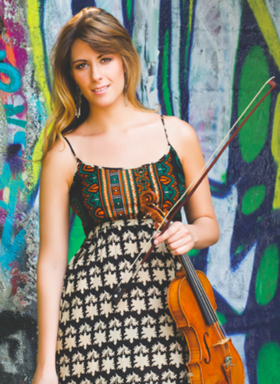
If you are playing with an orchestra, you have to know the piece inside out – particularly if you have limited rehearsal time. Look at the score as if you were the conductor; find a conductor to walk you through any spots that need extra care. That way, if something goes wrong in the performance you will know how to save it. Of course, you can ask a pianist to play the orchestral reduction with you many times, but if you do that you also have to ask them not to be too nice. An orchestra is much bigger and clumsier, and won’t be able to follow you as easily as a pianist can.
Before your first rehearsal, analyse your interpretation and know which bits you play differently from what the orchestra or conductor may expect. Have a clear idea of which spots may create problems, point them out, and play them to the conductor in advance, if time is tight. In the rehearsal, don’t be so shy and polite that you follow the orchestra rather than play what you would like. Exaggerate your ideas and colours, because when you’re on stage, full of adrenalin, you’ll probably just close your eyes and play what you’re used to.
Get all your ideas out there on the plate in the rehearsal, so that you don’t give the orchestra or conductor too many surprises during the performance! It can be difficult when the conductor is also a jury member, because you may feel that you’re being judged for your ideas. If this happens, don’t feel obliged or pressured to fulfil that person’s expectations.
The choice of piece is also important: some are more dangerous than others, if you don’t know the orchestra or conductor and don’t have much rehearsal time. In the second and fourth movements of Shostakovich’s Violin Concerto no.1, for example, the soloist is in such close, intricate dialogue with the wind instruments that it’s hard to recover if there’s an accident. Once, in a competition final, I saw an orchestra fall so out of synch with the violinist that they had to stop partway through the second movement. It can be better to choose something less risky, like the Brahms or Tchaikovsky, unless you know a piece so well and you’ve performed it so many times that you’re confident you will be able to overcome any problems.
Francesca Dego is an Italian–American violinist, international soloist and winner of the 2008 Paganini Competition.
ARTO NORAS
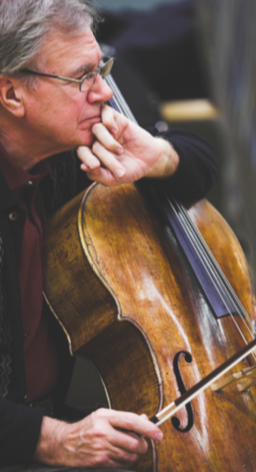
Playing with an orchestra, even if time is short, should be no more difficult than other forms of performance: soloists can prepare their concertos with a piano accompaniment beforehand. Rehearsing 20th-century works with orchestra for the first time, on the other hand, is a big challenge, even for very experienced soloists. The only solution is to prepare profoundly by studying not only the solo part but also the orchestralscore. Soloists have to be able to pick up and listen to all the different important instrument groups of the orchestra at the same time as playing their own part, and this is not easy. If you discover anything unexpected in the score during the first rehearsal with orchestra, it is already too late to study it.
Even if you think you are ready, there can still be surprises. In 1999 I prepared Penderecki’s complex Second Cello Concerto very thoroughly, for a performance conducted by Maestro Penderecki himself. At this time I did not know the composer very well, and I didn’t have an opportunity to work on the concerto with him beforehand, although I had listened to the recording of his performance with Rostropovich. In my first rehearsal with the orchestra, Penderecki conducted the four-minute-long orchestral overture at almost twice the speed of the recording! It was a horrible shock. I turned more and more red, green and sweaty as I tried to work out how I could survive playing this very difficult concerto at such an ultra-fast tempo. When the solo part began, I had no choice but to continue at the tempo I had learnt.
Penderecki gave me much kind advice during the rehearsal, but never mentioned the tempo. Afterwards I told him how horrified I had been during the overture. He was astonished and asked me why, so I told him that Rostropovich’s recording has been at half the speed. He smiled and said, ‘Oh, you know, that interpretation was for ten years ago!’ It was a reminder that interpretation and performance are not rigid, even in the mind of the composer; and that we should never make assumptions about what is the ‘right’ way to play. In general, I would say that orchestras and conductors are eager to work with young musicians to bring out the best of their playing and interpretation.
Arto Noras is a Finnish cello soloist, teacher and jury member at competitions including the Pablo Casals International Cello Competition, International Tchaikovsky Competition and Osaka International Chamber Music Competition.
HANNU LINTU
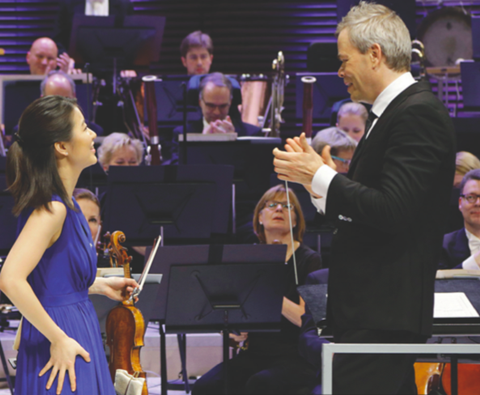
I’ve conducted at the final of the International Jean Sibelius Violin Competition twice, and the Joseph Joachim International Violin Competition once, and have noticed that all winners have one thing in common: they understand that a concerto performance is something that is done together. When Pekka Kuusisto, Alina Pogostkina and Nikita Boriso-Glebsky came to the Sibelius Competition, I was sure that they would make it into the finals, and almost certain that they were going to win (all of them did), because they had this incredible skill of communicating with the orchestra.
Even if young musicians do not have the opportunity to practise with an orchestra very often, they should play as much chamber music as possible, to develop their communication skills. They should also know the score and the elements that are important from an ensemble point of view – for instance, the role the winds and horns have in a basic concerto accompaniment. It’s useful to understand that it is not always the orchestra and conductor that have to follow the soloist: sometimes it is the other way around.
In the coda of the first movement of the Sibelius Violin Concerto, for example, the violin plays saltando arpeggios while the flutes, and later the clarinets, play the theme. The soloist must follow the flutes and the clarinets. That’s always one of the horror moments of every competition. Often there is no chance for the competitor to meet the conductor before the first rehearsal. Many competitions make a mistake here, and it can be disastrous: it’s important to discuss transitions and tempos, and for the conductor and soloist to get to know each other’s personalities.
Instead, there’s half an hour of rehearsal time to solve all problems in front of the orchestra. That means we try to play as much as possible, so that the orchestra can get used to how each soloist plays, their tempos, their sound and any balance issues there might be. Everybody needs to be communicative, both musically and socially.
In competitions, the orchestras and conductors always want to help. If my interpretation differs from a soloist’s, I’ll try to keep my mouth shut and do my best. When the competitors really want to be free with their interpretations, it isn’t always possible to do what they want: many are used to playing with pianists who can follow every detail, but the orchestra is a heavier instrument, and there are things that cannot be followed instantly. It can be difficult if they rush or drag unintentionally, but if they are musically strong and charismatic, and change tempo or take freedoms based on logical musical thinking, it can be very rewarding. In the real world, outside the competition circuit, there can be heated discussions, but the problems are almost always solved. I have parted as friends with most of the soloists I’ve played with.
Hannu Lintu is the chief conductor of the Finnish Radio Symphony Orchestra and a conductor at the Jean Sibelius Violin Competition
Read: Inmo Yang wins 2022 Jean Sibelius Violin Competition
Listen: The Strad Podcast Episode #1: Lisa Batiashvili on the Sibelius Violin Concerto
That festival feeling: Postcard from Odense
- 1
- 2
- 3
- 4
- 5
- 6
 Currently reading
Currently readingHow do you prepare for a concerto competition?
- 7
- 8
- 9
- 10
- 11
- 12
- 13
- 14















































No comments yet